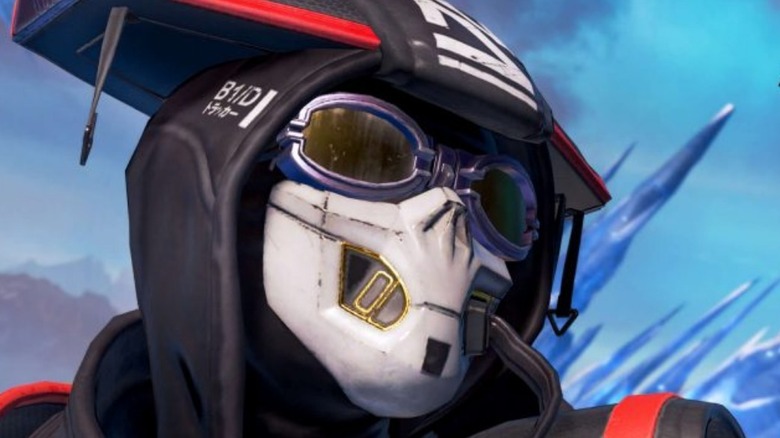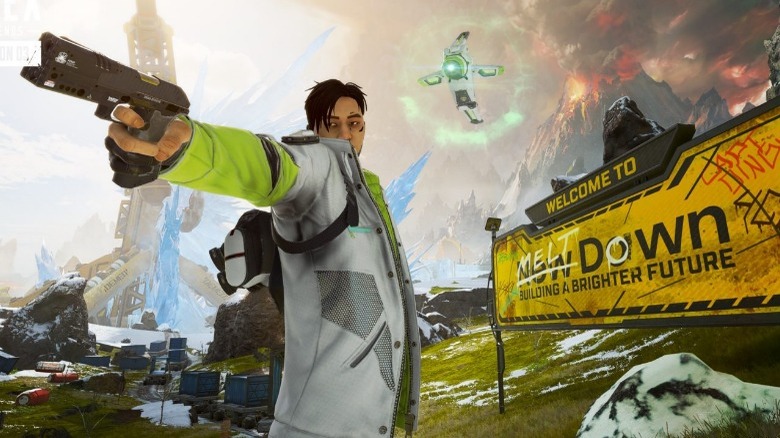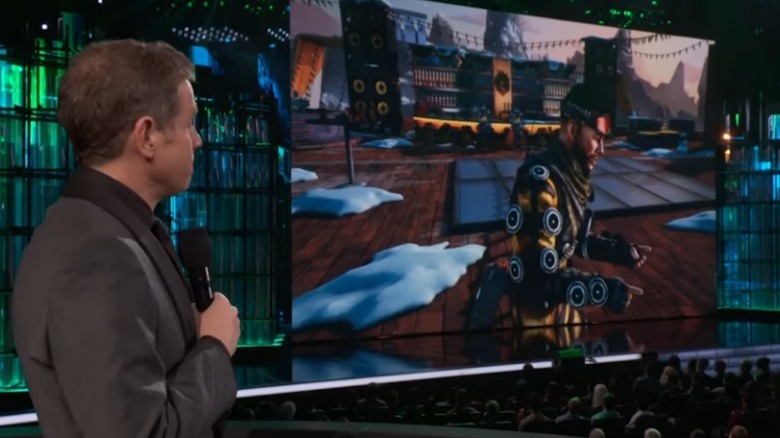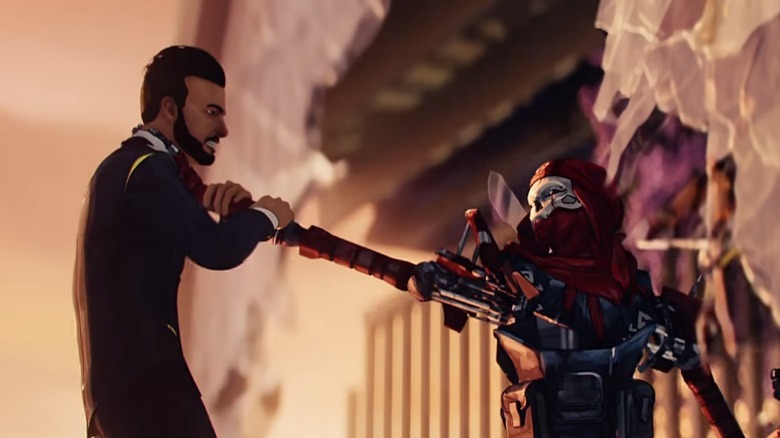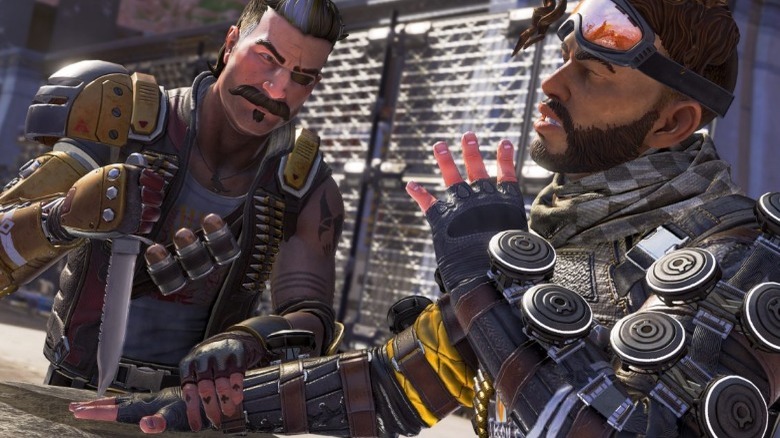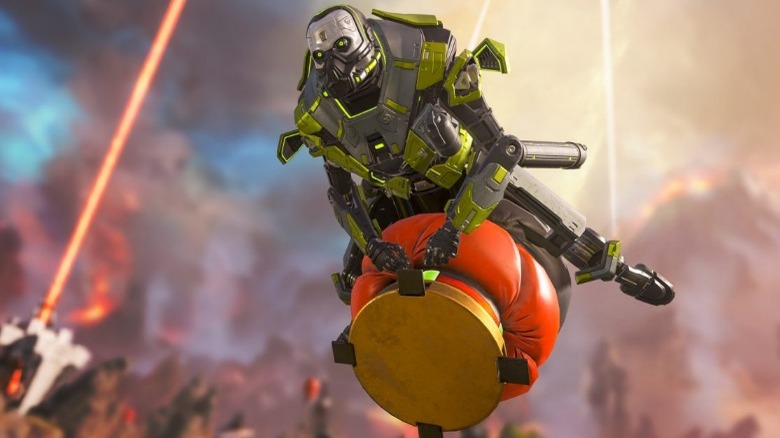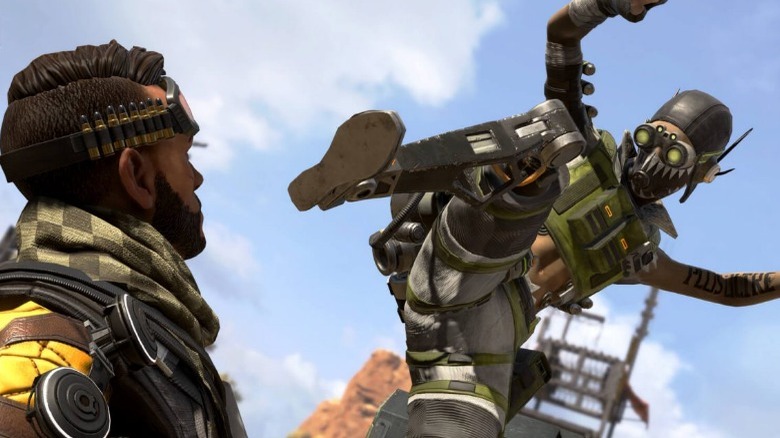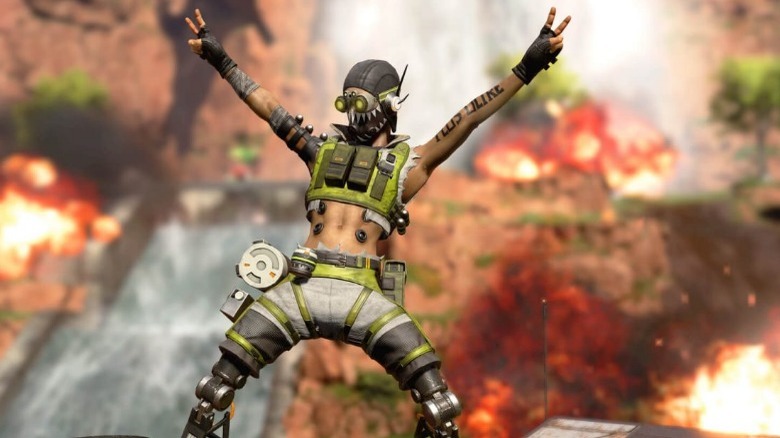What Apex Legends Looks Like Without Special Effects
Almost every piece of visual media is illusory. Movies and television are designed to draw audiences in and make them believe that what they're seeing is real. Well, audiences usually know that what they see on TV isn't real (emphasis on usually), but special effects are meant to complete the illusion. That goes quadruple for video games such as "Apex Legends." Many viewers wonder what these products look like without their digital enhancements.
Now, you might balk at that concept, since video games are computer generated images (CGI) all the way down. Everything in "Apex Legends," from Gibraltar's topknot to Pathfinder's positive attitude, is the product of special effects, so what do you get when you remove all that? Surprisingly, the answer isn't as empty as Mirage's holograms.
If you dig deep enough into the "Apex Legends" development cycle, you can peek behind the curtain and learn how certain animations and scenes were made. Virtually every asset in the game is the product of motion capture (mocap), general animation wizardry, and passionate developers — and there's an abundance of behind the scenes footage available, showing fans that impressive process. Here's what "Apex Legends" looks like without the special effects.
Prop up those animations
One of the biggest hurdles of special effects is in creating realistic reactions. How do directors ensure that actors will respond realistically to something that isn't actually on the set? Audience immersion is easily destroyed when live characters maintain eye contact with a CGI dragon's elbow instead of its eyes during a conversation. The same goes for handling fictional items, which is where props come into play.
Since many mocapped animations involve characters handling guns in "Apex Legends," actors usually wield props to give these and other items a semblance of heft. Guns are fairly easy to simulate, and mocap animators use everything from squirt pistols to Nerf guns when making firearm-centric animations. But these toy armaments only work for standard arsenals. When a mocap actor needs to simulate the handling of something more exotic, such as Rampart's minigun or a rampaging beast, developers typically craft and use custom props that aren't available in a local toy store.
However, props aren't the only solution. If an animation calls for something a little more dangerous than a dart gun, such as a knife, the mocap actor simply gives it their all while merely pretending to hold something, and the weapon is added later. Some mocap actors are so dexterous they can record realistic animations without assistance from physical items.
Mocap actors deserve plenty of props for going the distance and using physical items to give characters more realistic weapon-handling physics. Even Loba's mocapper walked a mile in her Legend's shoes by wearing high heels during recording sessions.
Rendered in front of a live studio audience
Filming CGI is actually more complicated than filming reality. You need to build CGI models, create the animations, put the scene together, and wait for them to render. In reality, people who serve as the models come prebuilt, and directors don't need to wait for programs to calculate how lighting will behave. However, "Apex Legends" is bridging the time gap, thanks to a partnership between studios.
In 2019, Mirage crashed The Game Awards to kick off the "Apex Legends" Holo-day Bash event. The announcement impressed audiences with plenty of skins and gifts — but what truly blew viewers away was the ceremony's host, ex-G4 anchor Geoff Keighley, completing the illusion by talking to Mirage (or at least his actor, Roger Craig Smith) as if he were there live. Keighley seamlessly timed his lines to match Mirage's pre-recorded... wait, what do you mean it actually was live?
Yes, turns out Mirage's party crashing was performed in real time, thanks to the combined forces of motion capture studio Animatrik, digital facial capture firm Cubic Motion, and visual effects company The Mill. Every action performed by Smith was seamlessly converted into animation and streamed to The Game Awards via an "experimental real-time shooting technique." The result effectively tricked audiences into thinking they were watching a pre-recorded performance, which fits Mirage's trickster M.O.
While the performance required a hefty number of computers, cameras, and mocap equipment, they all cut down the rendering time to negligible nanoseconds. With a bit of streamlining, this technology could represent the future of mocapping — or even Vtubing.
Animation is a team effort
Many animations are created in a vacuum. After all, you don't really need more than one actor to make Octane run like a maniac hopped up on adrenaline and sugar. However, some animations are more complicated, involving a lot of assets moving in sync.
The reveal trailer for Revenant is a prime example since it is a two-minute fight sequence in close quarters instead of a gunfight. Filming all the side characters Revenant slaughters individually would have been inefficient, so the developers wisely opted to record numerous people at once in an extended take. Each actor was secured in a mocap suit, and some were strapped to wire suspension systems to help capture Revenant's robotic strength. Not Revenant's actor, though — he didn't need any assistance pulling off Revenant's inhuman, window-shattering flip.
Because of the trailer's complex nature, the actors would have had to choreograph the stunts first (then again, they tend to practice quite a bit before and during filming). Also, the cameras captured way more action than audiences get to see in the finished product. While the trailer only features approximately two seconds of Revenant climbing up a wall like a metal spider of death, judging by the behind-the-scenes video, animators captured many more takes and angles of the sequence.
To this day, Revenant's trailer remains one of the busiest videos shot for "Apex Legends," possibly only surpassed by Fuse's reveal. Revenant's video wouldn't have been possible without several actors piling into a mocap arena and pretending to be slaughtered.
Homebrewed mocap madness
When COVID-19 started causing nationwide lockdowns, many companies adopted a work-from-home model. This was handy for regular jobs where employees just plug data into computers, but "Apex Legends" is not one of those. The game's constant development relies on mocap, which usually requires heavy equipment and dedicated studios. Well, the good thing about technology is that as it advances, it becomes more compact.
During an interview with IGN, Principal Animator Moy Parra revealed that the shift in development was challenging since quarantine orders came through right as Respawn Entertainment entered a new mocap phase. The studio thought quarantine would only last two weeks, but when it didn't, Respawn received a handy tip about using new remote mocap suits that didn't require in-studio appearance. Thanks to these suits, Respawn was able to craft many new animations, such as Revenant's Suffering Silence emote.
Parra admitted that the suits don't provide as much fidelity as a bona fide mocap studio, but they were well worth the effort. Plus, the animators had a reason to polish and alter animations more than usual.
Despite the impressive nature of the remote mocap suits, they were only a band aid solution. Eventually, Respawn figured out how to staff the mocap stage with a skeleton crew. However, if the studio ever needs to revert to a remote working setup, the animation team still has the means.
Batches of work and animations
Creating a piece of visual media, be it a movie or video game, is like writing an essay. You first create a rough draft that gives an idea of what the final product should look like, then you flesh it out. Next come the revisions, during which time you polish what works and change or toss what doesn't. Eventually, you have a finished product. This technique is standard procedure for animators, including the ones who work on "Apex Legends."
Before an animation can be created, developers need to sketch out where they want a model's limbs to sit and when. This process, known as blocking, provides markers that influence the future of the model. After blocking is complete, "Apex Legends" animators start, well, actually animating. This process could involve mocap or keyframes (manually controlling the assets by hand).
Once the animations are complete, the staff is faced with a daunting task: They have to critique their own work. Is the animation flashy enough? Does it fit the model's character? In many cases, the answer is no, so animators need to tweak the animations before they can finally polish the result. This happened to the game's Revenant and Bloodhound emotes, just to name a few. In Revenant's case, the mocap sessions show a few different examples of movements that didn't make the final cut. Also, rudimentary particle effects are added somewhere along the line, sometimes as early as blocking, to approximate how the final product will look.
After countless hours of reworks and polish, the models and animations are ready for the Apex Games.
It takes two to film a Finisher
In "Apex Legends," the best (or at least flashiest) way to end an opponent is with a finisher. Since they are some of the few in-game animations that feature character interactions, you might wonder if finishers are created by mirroring the interactions of two mocap actors. Well, yes and no.
In reality, all the finishers in "Apex Legends" are created by stapling animations together. The "simplest" of finishers, such as Caustic bashing the life out of an opponent, involve one mocap actor portraying Caustic and another portraying his victim five feet away. However, some finishers are a bit more eccentric. For instance, Horizon can suck enemies into her black hole-generating vacuum N.E.W.T. — how would an animator create that? By stitching an animation of Horizon opening her robot companion with a separate animation of someone being sucked in, that's now.
However, some finishers require a bit more surgery to make characters pull off these stunts. Octane is a good example of this, since he's an adrenaline junkie who sits on grenades for selfies. Many of his animations are crafted by mashing mocap recordings together. In one finisher, Octane uses his prosthetic legs like a pneumatic battering ram, and that animation was crafted by stitching together one mocap session of Octane's actor standing over a victim with another session where his mocap stand-in kicks off of a gym cushion.
Essentially, it's impossible to create finishers in "Apex Legends" without melding one animation with another. Otherwise, Respawn Entertainment would have had to send countless mocap actors to the hospital.
T-posing: It's not just for in-game models
When an animation goes awry in a video game, its model typically reverts to a T-pose — literally the default position of all models before they are animated. Somehow, that animation industry standard mutated into a meme that eventually infected real life. However, while some people might enter a T-pose for the laughs, the developers of "Apex Legends" use it quite often for work.
Since video game models relapse into a T-pose when devoid of animations, and since the lion's share of animations in "Apex Legends" are created through mocap, it stands to reason that mocap actors use a T-pose as a point of reference — and that is indeed the case. After most recordings, mocap actors wrap up with a T-pose. It doesn't matter whether they were successful or goofed up.
You might wonder if mocap actors have to bring things full circle and start with a T-pose as well. Not always, because they apparently didn't use T-poses during the mocap sessions for Crypto's reveal trailer. Then again, those were animations for a pre-rendered video. Trailer models can only use custom animations dictated by the director, while in-game models need to access a library of prebuilt animations and swap between them on the fly — if the game can't cope with a swap, it gives up and uses a T-pose instead. You don't really need a t-pose when the risk of animation failure is less than zero, do you?
Gamers might hate seeing a T-pose in action, but they are a necessary part of the animation lifecycle in virtually every game, including "Apex Legends."

